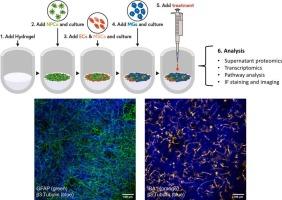纳入小胶质细胞的类神经器官评估已知发育性神经毒素诱导的神经炎症和毒性
IF 2.9
Q2 TOXICOLOGY
引用次数: 0
摘要
在体外3D细胞构建中使用ipsc衍生的复合物是一种更准确地预测人类神经毒性和减少动物模型使用的有希望的途径。我们已经生成了一个神经类器官模型,其中包含ipsc衍生的小胶质细胞,并能够对工业使用的不同模式和化学化合物的临床前候选药物诱导的神经炎症进行审讯。在这里,我们描述了该模型系统的产生和表征及其在评估毒性方面的应用。我们将神经免疫类器官暴露于多种发育性神经毒素中,并通过将LDH、GFAP和NF-L释放到细胞培养上清液中来测量细胞损伤。此外,为了确定这些化合物是否导致小胶质细胞介导的炎症激活,我们测量了IL-8的分泌,并使用大量RNA测序评估了小胶质细胞特异性基因转录分析。使用RNA测序数据中差异表达基因的Spearman相关矩阵和使用Gene Ontology Enrichment的途径分析显示,小胶质细胞可能在这些化合物的毒性中发挥作用,这在标准化的神经毒性测试中被广泛忽视。用醋酸铅处理类器官显示了IL-8分泌的剂量-反应曲线和小胶质细胞形态的改变。我们的研究结果表明,直接的神经毒性和间接的神经炎症机制都有助于这些化合物在发育中的中枢神经系统中产生潜在的有害影响。本文章由计算机程序翻译,如有差异,请以英文原文为准。

Neural organoids incorporating microglia to assess neuroinflammation and toxicities induced by known developmental neurotoxins
The use of iPSC-derived complex in vitro 3D cellular constructs is a promising avenue to more accurately predict human neural toxicities and reduce the use of animal models. We have generated a neural organoid model which incorporates iPSC-derived microglia and enables interrogation of neuroinflammation induced by pre-clinical drug candidates of varying modalities and chemical compounds in industrial use. Herein we describe the generation and characterization of this model system and its utility in assessing toxicity. We exposed the neuroimmune organoids to a variety of developmental neurotoxins and measured cellular damage by release of LDH, GFAP, and NF-L into the cell culture supernatants. Additionally, to determine whether the compounds led to activation of microglia-mediated inflammation, we measured IL-8 secretion and assessed microglia-specific gene transcriptional analysis using bulk RNA sequencing. Spearman correlation matrices using both differentially expressed genes in the RNA sequencing data and pathway analysis using Gene Ontology Enrichment revealed that microglia may play a role in the toxicity of these compounds which has been widely overlooked in standardized neurotoxicity tests. Treatment of the organoids with lead acetate demonstrates a dose–response curve of IL-8 secretion and alterations in the microglial morphology. Our findings suggest that both direct neurotoxicity and indirect neuroinflammatory mechanisms contribute to the potentially harmful effects of these compounds in the developing central nervous system.
求助全文
通过发布文献求助,成功后即可免费获取论文全文。
去求助
来源期刊

Current Research in Toxicology
Environmental Science-Health, Toxicology and Mutagenesis
CiteScore
4.70
自引率
3.00%
发文量
33
审稿时长
82 days
 求助内容:
求助内容: 应助结果提醒方式:
应助结果提醒方式:


